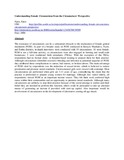| dc.contributor.author | Njeru, Enos H N | |
| dc.date.accessioned | 2013-06-25T07:56:52Z | |
| dc.date.available | 2013-06-25T07:56:52Z | |
| dc.date.issued | 2006 | |
| dc.identifier.citation | NTHIA, PROFNJERUEH. 1996. "Understanding Female Circumcision from the Circumcisers' Perspective. In Program and Abstracts for the Third Annual Meeting of AFRICLEN and PHSWOW at Hotel Equatoria, Kampala. In East African Medical Journal.. : African Wildlife Foundation. Nairobi | en |
| dc.identifier.uri | http://profiles.uonbi.ac.ke/enjeru/publications/understanding-female-circumcision-circumcisers-perspective | |
| dc.identifier.uri | http://erepository.uonbi.ac.ke:8080/xmlui/handle/123456789/39509 | |
| dc.description.abstract | The resistance of circumcisers can be a substantial obstacle to the eradication of female genital mutilation (FGM). As part of a broader study on FGM conducted in Kenya's Machakos, Nyeri, and Embu districts, in-depth interviews were conducted with 19 circumcisers. 18 were female. FGM is not a full-time activity, so circumcisers were also engaged in farming and small-scale businesses; 5 were traditional birth attendants (TBAs). With the exception of the TBAs, respondents had no formal clinic- or hospital-based training to prepare them for their practice. Although circumcisers identified excessive bleeding and infection as potential sequelae of FGM, they attributed these complications to curses, bad omens, or broken taboos. The main advantage of FGM cited by respondents was the reduction of sexual desire, which is believed to reduce prostitution and promote moral standards. Uncircumcised girls were viewed with contempt. Most circumcisions are performed when girls are 3-11 years of age, contradicting the claim that the practice is performed to prepare young women for marriage. Although fees varied widely, all respondents viewed FGM as an important income source. They felt their work conferred high status within their communities and an opportunity to promote moral standards. Although many circumcisers are unlikely to stop their practice because of the social prestige it confers and their belief they are destined to perform this function, others could be persuaded to take up alternate means of generating an income if provided with start-up capital. Also important would be involvement of circumcisers in the development of alternative coming-of-age rituals. | en |
| dc.language.iso | en | en |
| dc.publisher | University of Nairobi | en |
| dc.title | Understanding Female Circumcision from the Circumcisers' Perspective | en |
| dc.type | Article | en |
| local.publisher | College of Humanities and Social Sciences | en |

